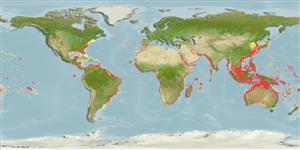Issue
This name has often been wrongly used for the more common Fistularia commersonii (Ref. 2334).
Environment: milieu / climate zone / profondeur / distribution range
Écologie
marin; saumâtre récifal; profondeur 10 - 200 m (Ref. 9563), usually 18 - 57 m (Ref. 47377). Tropical; 44°N - 39°S
Western Atlantic: Argentina (Ref. 86323), southern Brazil to Massachusetts (Ref. 47377). Eastern Atlantic: Galicia, Spain (Ref. 74931), Cape Blanc and Cape Verde to Angola (Ref. 6557). Mediterranean: Cadiz, Spain (southern Iberian Peninsula) (Ref. 34227). Reported from Walvis Bay, Namibia (Ref. 4272). Indo-West Pacific: East Africa, Red Sea, to the Hawaii and Tuamoto Is., north to southern Japan and the Ogasawara Islands, south to Victoria, Australia (Ref. 33390).
Taille / Poids / Âge
Maturité: Lm ? range ? - ? cm
Max length : 200 cm TL mâle / non sexé; (Ref. 26999); common length : 180 cm TL mâle / non sexé; (Ref. 47377); poids max. publié: 4.7 kg (Ref. 4883)
Épines dorsales (Total) : 0; Rayons mous dorsaux (Total) : 13 - 15; Épines anales: 0; Rayons mous anaux: 14 - 15. With a row of bony plates along the midline (absent in F. commersoni); reddish or brownish-orange in color (whereas F. commersoni is greenish-brown).
Body shape (shape guide): elongated.
Found in the sublittoral zone (Ref. 11230); inhabits coastal areas over soft bottoms, usually at depths greater than 10 m (Ref. 30573). Benthopelagic (Ref. 58302). Feeds on small fishes and shrimps (Ref. 3401). Maximum length reported is 200 cm TL (Ref. 26999), however, no specimen over 100 cm is known to J.E. Randall (Ref. 11441).
Life cycle and mating behavior
Maturité | Reproduction | Frai | Œufs | Fécondité | Larves
Fritzsche, R.A., 1990. Fistulariidae. p. 654-655. In J.C. Quero, J.C. Hureau, C. Karrer, A. Post and L. Saldanha (eds.) Check-list of the fishes of the eastern tropical Atlantic (CLOFETA). JNICT, Lisbon; SEI, Paris; and UNESCO, Paris. Vol. 2. (Ref. 6557)
Statut dans la liste rouge de l'IUCN (Ref. 130435: Version 2025-1)
Menace pour l'homme
Harmless
Utilisations par l'homme
Pêcheries: pêcheries vivrières; pêche sportive: oui
Outils
Articles particuliers
Télécharger en XML
Sources Internet
Estimates based on models
Preferred temperature (Réf.
123201): 21.3 - 29, mean 27.5 °C (based on 2574 cells).
Phylogenetic diversity index (Réf.
82804): PD
50 = 0.6250 [Uniqueness, from 0.5 = low to 2.0 = high].
Bayesian length-weight: a=0.00043 (0.00025 - 0.00073), b=3.06 (2.91 - 3.21), in cm total length, based on LWR estimates for this species & (Sub)family-body (Ref.
93245).
Niveau trophique (Réf.
69278): 4.4 ±0.5 se; based on diet studies.
Résilience (Réf.
120179): Milieu, temps minimum de doublement de population : 1,4 à 4,4 années (Preliminary K or Fecundity.).
Fishing Vulnerability (Ref.
59153): Very high vulnerability (90 of 100).
🛈
Nutrients (Ref.
124155): Calcium = 27.8 [13.8, 54.0] mg/100g; Iron = 0.659 [0.360, 1.241] mg/100g; Protein = 19 [18, 20] %; Omega3 = 0.112 [0.055, 0.241] g/100g; Selenium = 103 [49, 218] μg/100g; VitaminA = 19.3 [5.8, 63.6] μg/100g; Zinc = 0.747 [0.487, 1.175] mg/100g (wet weight);
